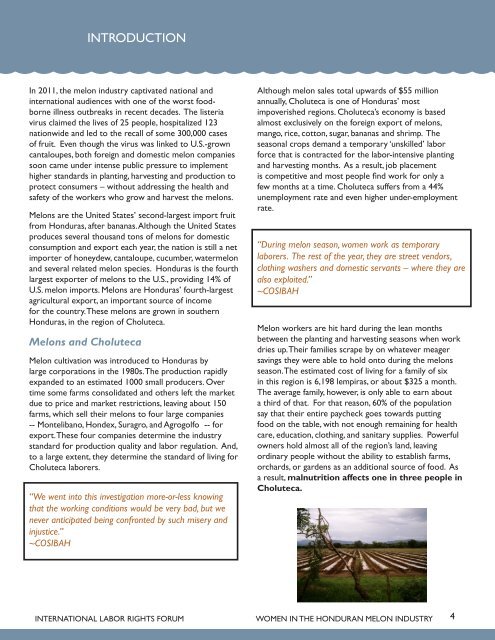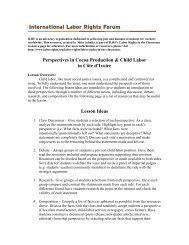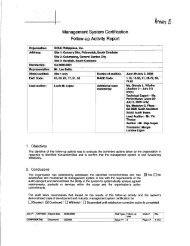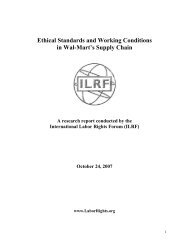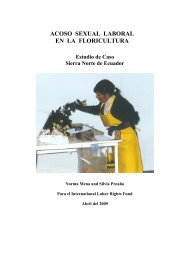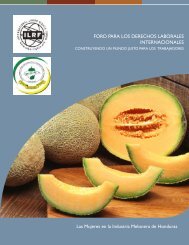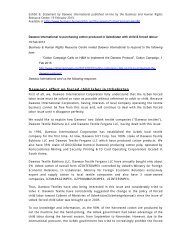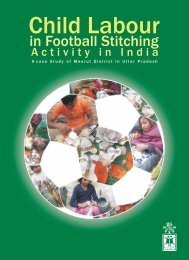Women in the Honduran Melon Industry - International Labor Rights ...
Women in the Honduran Melon Industry - International Labor Rights ...
Women in the Honduran Melon Industry - International Labor Rights ...
Create successful ePaper yourself
Turn your PDF publications into a flip-book with our unique Google optimized e-Paper software.
INTRODUCTIONIn 2011, <strong>the</strong> melon <strong>in</strong>dustry captivated national and<strong>in</strong>ternational audiences with one of <strong>the</strong> worst foodborneillness outbreaks <strong>in</strong> recent decades. The listeriavirus claimed <strong>the</strong> lives of 25 people, hospitalized 123nationwide and led to <strong>the</strong> recall of some 300,000 casesof fruit. Even though <strong>the</strong> virus was l<strong>in</strong>ked to U.S.-growncantaloupes, both foreign and domestic melon companiessoon came under <strong>in</strong>tense public pressure to implementhigher standards <strong>in</strong> plant<strong>in</strong>g, harvest<strong>in</strong>g and production toprotect consumers – without address<strong>in</strong>g <strong>the</strong> health andsafety of <strong>the</strong> workers who grow and harvest <strong>the</strong> melons.<strong>Melon</strong>s are <strong>the</strong> United States’ second-largest import fruitfrom Honduras, after bananas. Although <strong>the</strong> United Statesproduces several thousand tons of melons for domesticconsumption and export each year, <strong>the</strong> nation is still a netimporter of honeydew, cantaloupe, cucumber, watermelonand several related melon species. Honduras is <strong>the</strong> fourthlargest exporter of melons to <strong>the</strong> U.S., provid<strong>in</strong>g 14% ofU.S. melon imports. <strong>Melon</strong>s are Honduras’ fourth-largestagricultural export, an important source of <strong>in</strong>comefor <strong>the</strong> country. These melons are grown <strong>in</strong> sou<strong>the</strong>rnHonduras, <strong>in</strong> <strong>the</strong> region of Choluteca.<strong>Melon</strong>s and Choluteca<strong>Melon</strong> cultivation was <strong>in</strong>troduced to Honduras bylarge corporations <strong>in</strong> <strong>the</strong> 1980s. The production rapidlyexpanded to an estimated 1000 small producers. Overtime some farms consolidated and o<strong>the</strong>rs left <strong>the</strong> marketdue to price and market restrictions, leav<strong>in</strong>g about 150farms, which sell <strong>the</strong>ir melons to four large companies-- Montelibano, Hondex, Suragro, and Agrogolfo -- forexport. These four companies determ<strong>in</strong>e <strong>the</strong> <strong>in</strong>dustrystandard for production quality and labor regulation. And,to a large extent, <strong>the</strong>y determ<strong>in</strong>e <strong>the</strong> standard of liv<strong>in</strong>g forCholuteca laborers.“We went <strong>in</strong>to this <strong>in</strong>vestigation more-or-less know<strong>in</strong>gthat <strong>the</strong> work<strong>in</strong>g conditions would be very bad, but wenever anticipated be<strong>in</strong>g confronted by such misery and<strong>in</strong>justice.”~COSIBAHAlthough melon sales total upwards of $55 millionannually, Choluteca is one of Honduras’ mostimpoverished regions. Choluteca’s economy is basedalmost exclusively on <strong>the</strong> foreign export of melons,mango, rice, cotton, sugar, bananas and shrimp. Theseasonal crops demand a temporary ‘unskilled’ laborforce that is contracted for <strong>the</strong> labor-<strong>in</strong>tensive plant<strong>in</strong>gand harvest<strong>in</strong>g months. As a result, job placementis competitive and most people f<strong>in</strong>d work for only afew months at a time. Choluteca suffers from a 44%unemployment rate and even higher under-employmentrate.“Dur<strong>in</strong>g melon season, women work as temporarylaborers. The rest of <strong>the</strong> year, <strong>the</strong>y are street vendors,cloth<strong>in</strong>g washers and domestic servants – where <strong>the</strong>y arealso exploited.”~COSIBAH<strong>Melon</strong> workers are hit hard dur<strong>in</strong>g <strong>the</strong> lean monthsbetween <strong>the</strong> plant<strong>in</strong>g and harvest<strong>in</strong>g seasons when workdries up. Their families scrape by on whatever meagersav<strong>in</strong>gs <strong>the</strong>y were able to hold onto dur<strong>in</strong>g <strong>the</strong> melonsseason. The estimated cost of liv<strong>in</strong>g for a family of six<strong>in</strong> this region is 6,198 lempiras, or about $325 a month.The average family, however, is only able to earn abouta third of that. For that reason, 60% of <strong>the</strong> populationsay that <strong>the</strong>ir entire paycheck goes towards putt<strong>in</strong>gfood on <strong>the</strong> table, with not enough rema<strong>in</strong><strong>in</strong>g for healthcare, education, cloth<strong>in</strong>g, and sanitary supplies. Powerfulowners hold almost all of <strong>the</strong> region’s land, leav<strong>in</strong>gord<strong>in</strong>ary people without <strong>the</strong> ability to establish farms,orchards, or gardens as an additional source of food. Asa result, malnutrition affects one <strong>in</strong> three people <strong>in</strong>Choluteca.INTERNATIONAL LABOR RIGHTS FORUMWOMEN IN THE HONDURAN MELON INDUSTRY4


